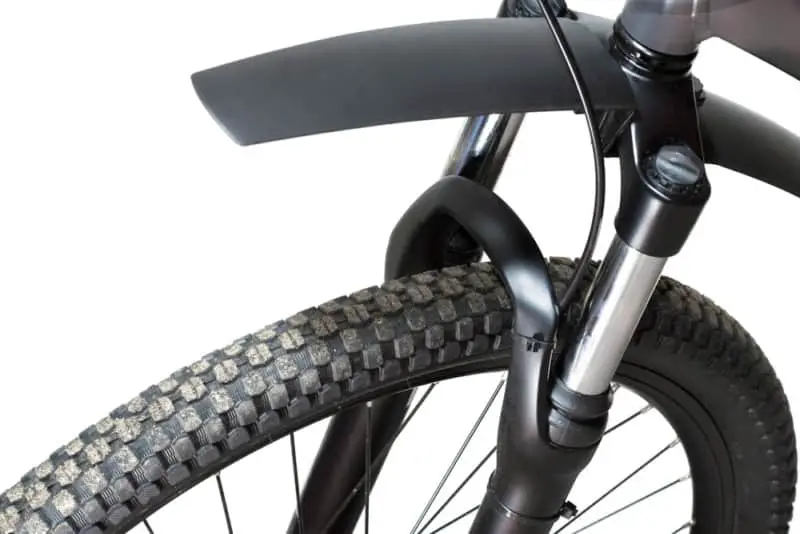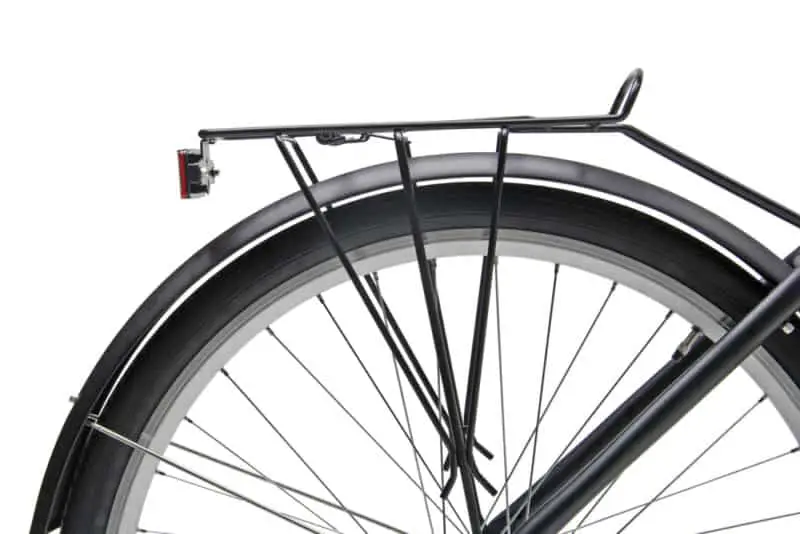The majority of new bikes today do not come stock with fenders…but there are tons of aftermarket options available. So this begs the question: do bike fenders actually work?
Bike fenders do a decent job of protecting much of your bike’s frame from getting dirty or scratched by trail debris, and help keep dirt and grime out of your fork’s seals. They also keep debris out of an equally important place: your face. This improves visibility, which is crucial to safe riding.
Would every bike and every type of rider benefit from the addition of fenders? And if so, how do you select the right one?
Get the answers to all your questions here!
The Purpose of Bike Fenders / Mudguards

Protects Your Bike Frame
A bike fender mounts to your fork directly above the front tire (rear fenders do exist, but they are less common). Its main purpose is to prevent dirt, mud and water from coating your bike frame.
You’ve probably noticed the treads on your tire like to pick up everything on the ground and fling it up in the air…and all over your bike. A fender acts as a gatekeeper to deflect much of this debris.
Aside from keeping your bike frame cleaner, a fender can also prevent it from getting scratched. Whether you’re a road cyclist or mountain biker, all riders will contend with loose dirt and rocks. These are the worst of the debris: when your tire whips them off the ground at high speed, they can easily ding and scratch your beautiful bike frame.
While this may not be as big a deal to mountain bikers (we have so many other ways of scratching our bike frames!) few things are more annoying than taking meticulous care of your bike…only to have a small rock chip the paint job. While a paint chip is cosmetic, larger rocks have the potential to do more significant damage to your bike’s components.
Bike fenders can deflect these hazards before they cause any significant damage.
Protects Your Fork
While scratches and paint chips on your bike frame may be unsightly, they rarely have any effect on your bike’s performance. Your fork, however, is a different story.
Scratches on your fork’s upper stanchions can impede its ability to go through its travel smoothly, as can dirt, grime and water that work their way into your fork’s seals (if you’re a road cyclist with a rigid fork on your bike, this won’t be a concern).
A fender’s placement above the tire but below your fork’s upper stanchions positions it perfectly to deflect dirt and water from sticking to the uppers and then getting forced down into the seals when the fork compresses. This also protects the uppers from rocks and other hard objects that might get thrown up from the ground.
Given its position, a fender won’t protect your fork’s lower stanchions, but slight scratches and chips here are only cosmetic…which isn’t the case for damage to the upper stanchions.
The uppers need to be as smooth as possible to compress fluidly, but also to prevent damage to the seals. Fork seals consist of a delicate foam insert coated in oil. A scratch on the upper stanchion could leave sharp edges, which could easily chew up that foam insert and cause the fork to leak oil.
That oil helps lubricate the fork’s stanchions, which undergo a lot of friction. Friction releases energy in the form of heat…no lubrication means more heat buildup, which can cause your fork’s internal components to wear out much quicker.
I’m not sure the last time you had to buy a replacement fork, but they’re not cheap…most cost more than my first mountain bike did!
Keeps Your Face / Back Clean
Sure, it may not be a bike component, but you know what’s equally important to keep clean and undamaged by rocks and debris? You!
If you frequently ride in muddy or wet conditions, you’ll probably find a lot of what’s on the ground ends up all over your riding gear. That’s nothing a good cycle in the washing machine can’t fix, but you don’t want that debris ending up in your face.
First off, you should be wearing glasses or goggles to protect your eyes from harm, but even if you do, when mud and water coats your goggles it impairs your view. If you can’t see the road or trail in front of you, that’s a serious safety issue.
Your face is directly above and behind the front tire…meaning right in the firing line for dirt, mud and rocks the tire will kick up. Adding a bike fender can deflect much of that debris and water away from your eyes so you can see where you’re going.
Good visibility will keep you from inadvertently discovering an “alternate” line off the road or trail and into a tree, ditch, river, oncoming traffic…or any other place you wouldn’t want to end up.
And if you’ve ever received a stream of dirty puddle water on your back-side, you’ll know first-hand that it’s not pleasant. A rear fender (although their less common) can help to reduce or eliminate this issue.
Do Bike Fenders Actually Work (i.e. Fulfill Their Purpose)?

So, bike fenders sound great, but do they actually do what they say they do? Let’s grade their work:
Protects Your Bike Frame: C+
Bike fenders do offer some protection for your frame from dirt, mud and flying rocks, but only the parts of the frame directly above the fender. This is better than nothing, but they do little to protect your downtube, bottom bracket, entire rear triangle and drivetrain.
Non-coincidentally, these are the areas most prone to getting dirty or taking big hits. The rear suspension and drivetrain are relatively sensitive to damage: a single well-placed rock strike can throw your pedalling and shifting performance completely off-balance.
The downtube and bottom bracket should be well-armored against damage because they’re going to take a beating no matter where you ride. They’re also the sections of your frame that will receive the most punishment if you try and roll a drop that’s too big, or you massively case a jump.
A bike fender has no hope of protecting against these mishaps.
Protects Your Fork: B+
A fender does a much better job of protecting your fork and keeping it clean…or the most important parts of it at least.
Since a fender sits right above the tire, it leaves your fork’s lowers exposed to dirt, water and flying debris. It won’t protect your lowers from dings and scratches if rocks decide to fly off the ground and assault your bike. However, the lowers are pretty robust: any small dings or chips won’t negatively impact performance.
The uppers are not as tough. If they get scratched or dented, you’ll notice a serious reduction in your fork’s ability to move smoothly through its travel. Dirt and water can also get pushed into the seals between the upper and lower stanchions, causing internal damage.
All this can be mitigated with the addition of a bike fender. A fender is well positioned to keep a lot of dirt, water and rocks from getting inside your fork and wreaking havoc.
Keeps Your Face / Back Clean: A
Here’s something a bike fender does very well.
Your face is pretty important, so you should try to keep dirt, mud and rocks from hitting it during your rides. Adding a bike fender is a great way to do this. A clean face and clean goggles means better visibility, which means less risk of injury.
A rear bike fender can also help you avoid that telltale “skidmark” on the back of their cycling shorts after a ride (or at least I hope that’s the reason).
However, even if you have fenders on both wheels, this won’t completely protect your body from the rain, dirt, and grime. But getting dirty on a ride just comes with the territory. If you don’t like it, you’re in the wrong sport!
Do YOU Need a Fender on Your Bike?
So given their actual benefits, should everyone add a fender to their bike? Well it certainly wouldn’t hurt, but the amount it benefits you will depend on the conditions you ride in most often.
If you’re a mountain biker or road cyclist who frequently rides in wet, muddy or snowy conditions, a bike fender would be a good idea. Especially since they’re relatively cheap and don’t add much weight (if you’re concerned about that sort of thing).
If you’re a fair weather rider or your local trails are mostly dry and dusty, a fender isn’t as necessary. It can minimize the risk of flying rocks kicked up from the tire hitting you or your bike, so it may be something to consider regardless.
Some brands offer fenders in a wide variety of colors and designs, so even if you don’t need one, you may opt for one anyway to add some style to your bike. If that’s the case, go for it!
For a more comprehensive look at this topic, check out our article on whether a fender is necessary.
How to Choose a Bike Fender
First thing to note is that road bike and mountain bike fenders are very different, and not interchangeable. So make sure you are searching for fenders designed for your bike style.
Once you’re searching for the right type of fender, you’ll find that most are universal, meaning they can be mounted on any bike brand. The majority of them attach directly to your fork with zip-ties or velcro (for mountain bikes) or clips (for road bikes): no special tools or mounts necessary.
Fenders can generally be divided into two types: rigid and flexible.
Rigid fenders (like the Mucky Nutz MugGuard or Crud Roadracer) are more durable and usually provide more coverage over the tire, though this comes at a price and weight penalty. Also, they usually only come in black…not the most exciting.
Flexible fenders (like those from Ground Keeper) are generally cheaper and lighter and are offered in a range of color and design options, but they aren’t as durable or as large as rigid fenders.
If you ride in very wet, muddy conditions, you would benefit from a rigid fender that offers more coverage to keep mud and water at bay. If your riding conditions aren’t as poor, or you’re just looking to add some flair to your bike, a flexible fender will do just fine.
Now above I said that most fenders are universal. But there are two situations in which this may not be the case.
Before buying a fender, note the width of your tires. If you have especially wide tires (like on a “plus” or “fat” bike), a regular fender may not be wide enough, as your tires will rub on the side of the fender. Make sure to check the manufacturer’s recommendations: they should note the compatible tire width for each fender model.
A small number of fenders are also fork-specific. These fenders bolt or clip on to a fork without zip-ties. While this design is more stable, it’s also rather limiting. If your bike doesn’t have the fork the fender was designed for, it just won’t fit.
As long as the fender passes these two tests, you should have no problem mounting it to your bike, no matter the brand or style.
